
MM,
In a wx bb’s CC section, someone posted to another poster this:
You said a lot but very little related to my point. I said there haven't been MAJOR impacts to agriculture or large numbers of people losing their homes by the ocean. Meaning in this country. Neither has occurred.
By major, I mean massive price spikes (not inflation-driven) or shortages of food due to climate change.
——————-
I then replied with this:
“Regarding major impacts to crops, it’s actually been closer to the opposite with larger crops in many areas, including the US, due partially to:
-longer growing seasons due to GW
-ability to have decent crops further N due to GW
-increased CO2 itself, due to “fertilization effect”, leads to larger crops
I’ve posted about this earlier ITT.
So, who’s to say that CC will ever lead to shortages of food? It may continue to be a net positive for that for all anyone knows.”
———————-
Someone else then civilly replied to me:
“Do you have a reference for this? Per the articles below, we have had larger crops due to technology improvement not climate change. The impact of climate change depends on the crop and region. No large net impacts so far. On a global average, doesn't look like a disaster in the future either; but, some regions and crops may have significant negative impacts. Also need to consider extreme events which will pack a bigger punch in a warmer world. A bad year can be destabilizing regionally.
https://ourworldindata.org/crop-yields-climate-impact
https://ourworldindata.org/will-climate-change-affect-crop-yields-future
—————-
Hey MM,
I don’t doubt tech’s help. But I distinctly recall you many times posting about CC’s net positive influence on global crop sizes. That’s the only reason I posted about this.
Would you please provide the best two links from sources considered objective by the wx community to studies proving CC’s net + influence on food supply? Stuff from Watts or any site deemed to largely not fully agree with the concept of AGW wouldn’t cut it as like you we all there believe in AGW. I just want two links to as purely objective articles as possible about crop sizes. TIA
——————-
Edit: I just looked through the two “Our World in Data” links that that poster provided. The gist in regard to CC is that while wheat has been helped, due partially to much of it not being grown at low latitudes, corn has been/will be hurt due to much of it grown at low latitudes and it not helped nearly as much as wheat by the CO2 fertilization effect.
They emphasize that CC helps at higher latitudes and hurts at lower latitudes. So, it’s a mixed bag. They also say that crop sizes have overall increased due to tech, not CC.
Also, they say, “When considering the net impacts of climate on food production, we need to consider three key factors: higher concentrations of CO2, warmer temperatures, and changes in rainfall”
———-
Edit: Here’s a graph from the 1st article:
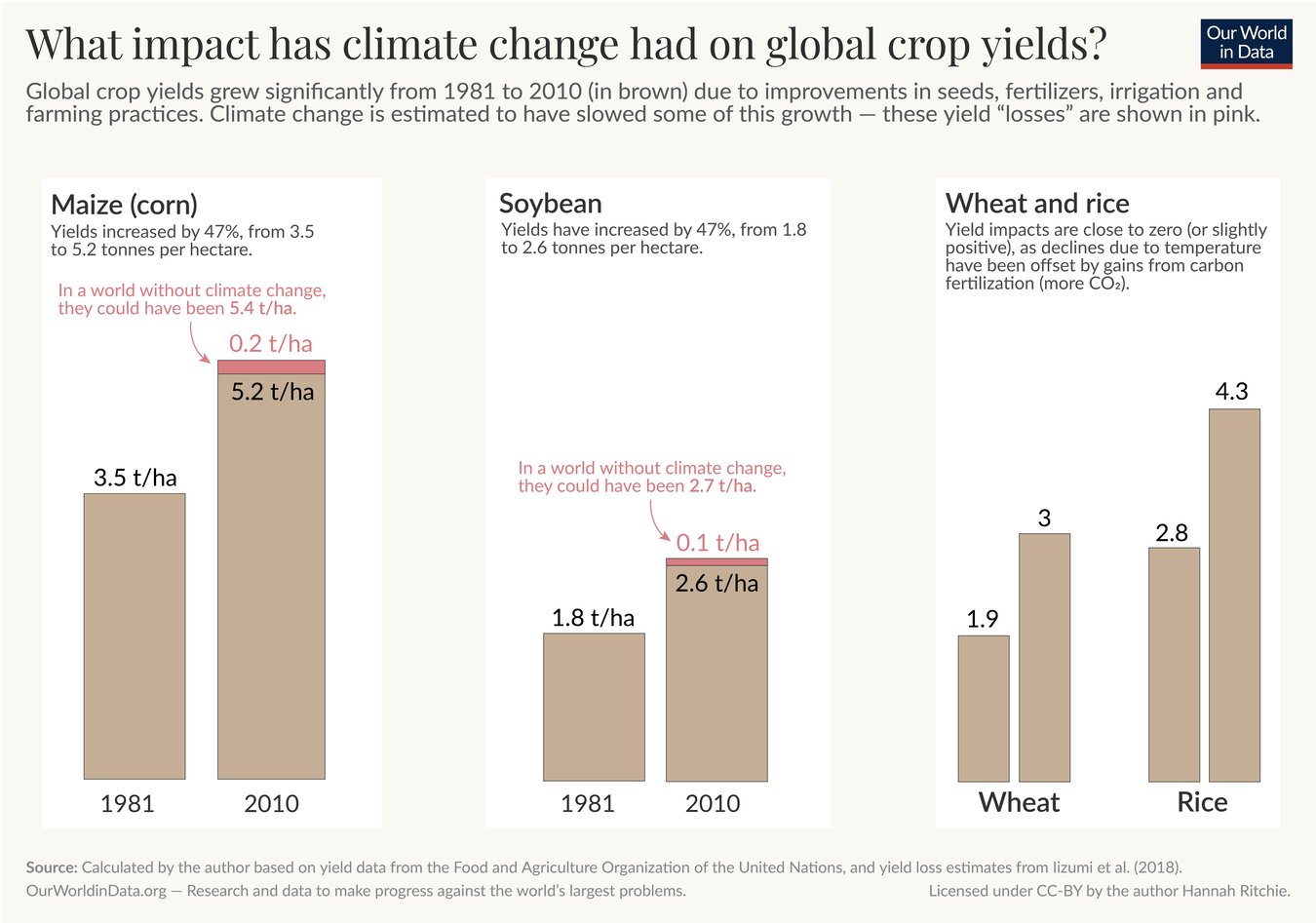
I'll give you some good agronomy science stuff in a minute, Larry!
The source you used is not a good one!
For instance, they make this assumption:
For context, we’re currently at around 420 ppm, and reaching 570 ppm would mean global temperatures are 2°C to 2.5°C higher than pre-industrial times.
The impact of increasing CO2 on temperature is LOGARITHMIC. The more that you add, the less the impact.
Why the Forcing from Carbon Dioxide Scales as the Logarithm of Its Concentration
https://romps.berkeley.edu/papers/pubdata/2020/logarithmic/20logarithmic.pdf
The radiation absorption bands of CO2 are almost saturated in the warm/humid areas of the planet because they overlap with the H2O absorption bands. This is why the warming has mostly been in the higher latitudes.
https://commons.wikimedia.org/wiki/File:Longwave_Absorption_Coefficients_of_H2O_and_CO2.svg
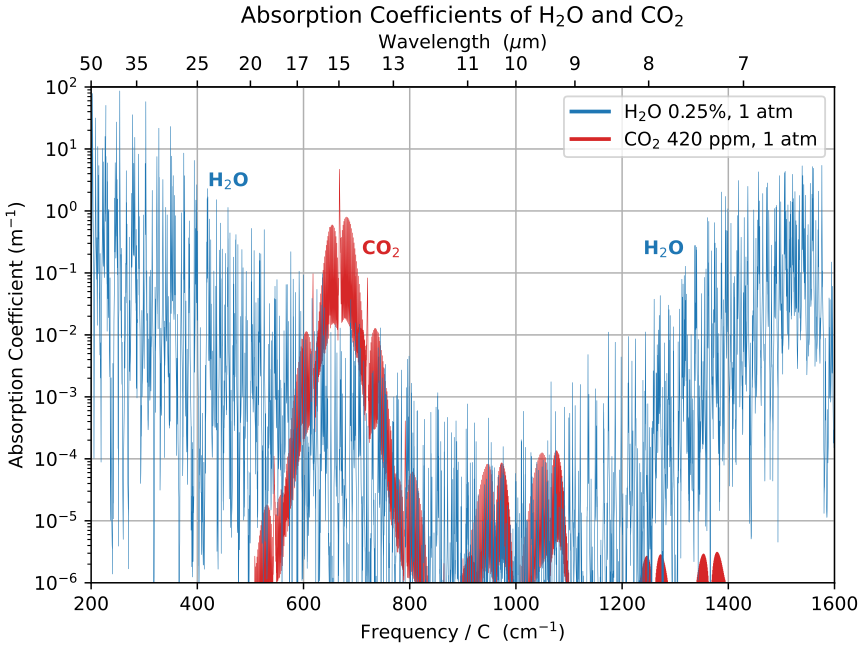
And the warming in the tropics(where cocoa is grown) is MUCH LESS than that of the high latitudes of the Northern Hemisphere.
+++++++++++++
Added: mike: You can see below on the graph that as CO2 increases, the warming/forcing impact per molecule drops.
The greatest forcing takes/took place from 0 to the current 430 parts per million.
Adding another 150 ppm will NOT have nearly the amount of warming impact that the last +150 ppm had.
The greenhouse effect
and carbon dioxide
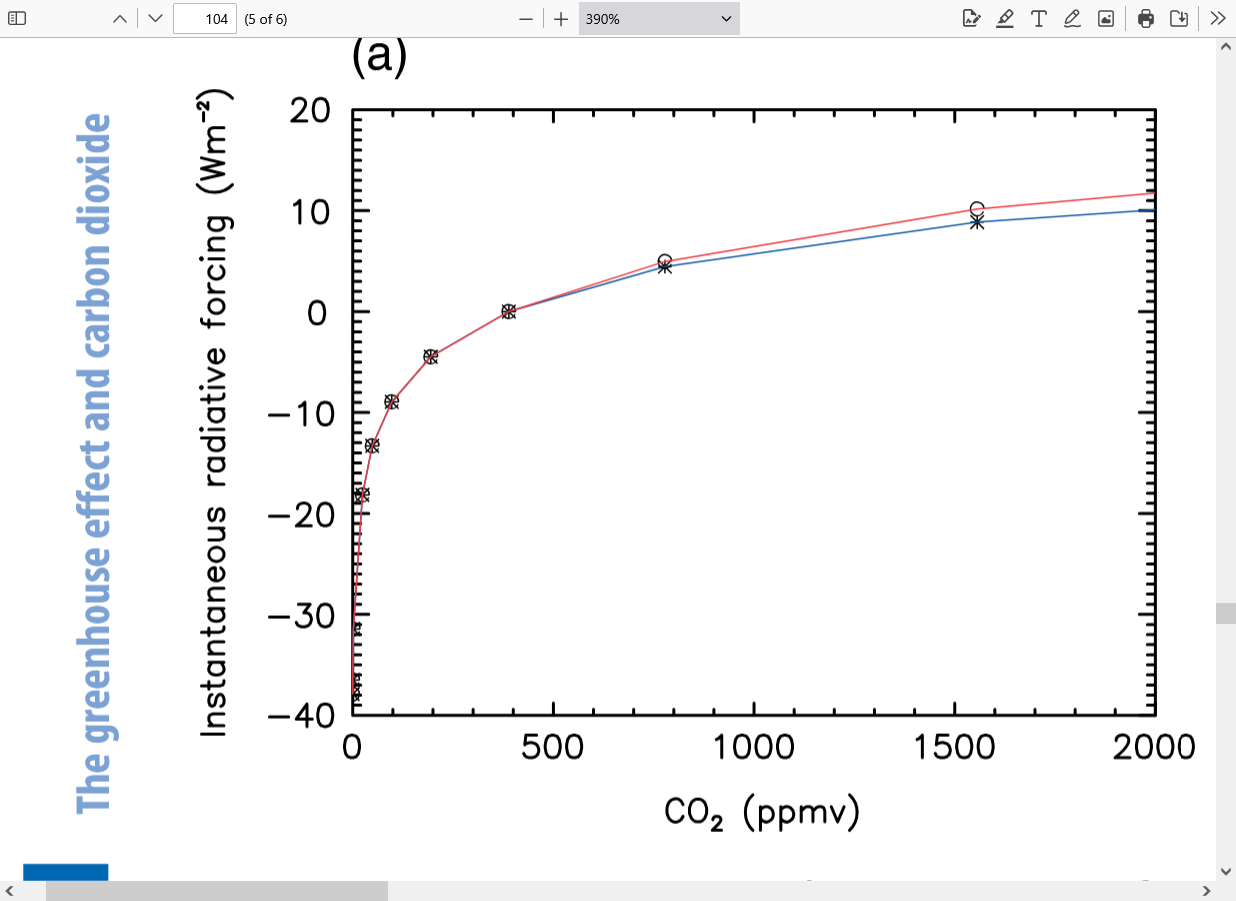
Climate models use the increase in H2O from the CO2 warming to AMPLIFY THE WARMING SEVERAL TIMES/ far beyond what the CO2 does.
Now for the agronomy. One can only speculate on how much of the robust global crop increases are from technology and how much from CO2/climate change.
But not in the laboratory where everything else is held constant but the CO2 is elevated.
This is the best site on the planet for that data!
In fact, the increase in CO2 is, like most crops massively increasing production of Cocoa. However, I was surprised that the number of studies for cocoa trees was so low.
http://www.co2science.org/data/plant_growth/dry/dry_subject.php
http://www.co2science.org/data/plant_growth/dry/dry_subject_c.php
http://www.co2science.org/data/plant_growth/dry/t/theobromac.php
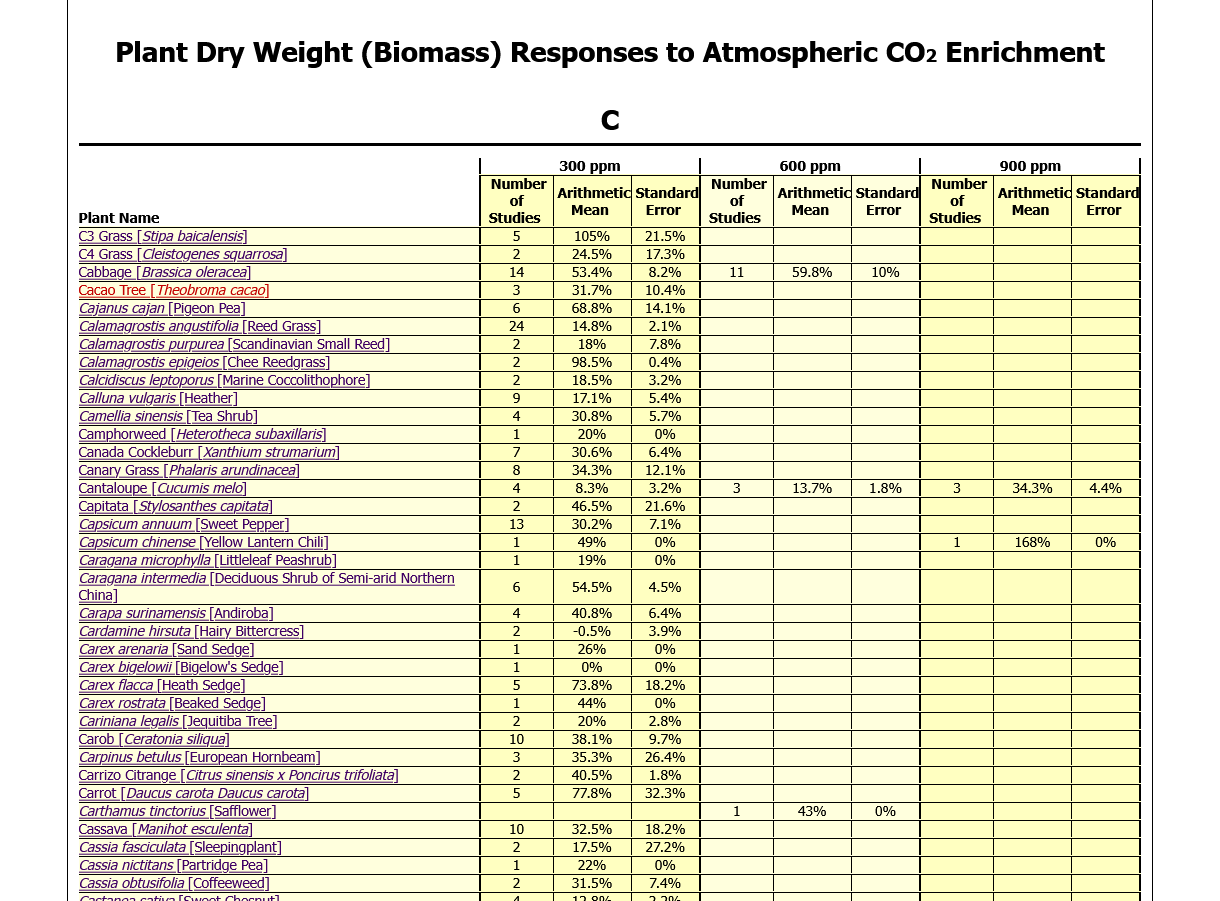
Theobroma cacao [Cacao Tree]
Statistics
| 300 ppm | 600 ppm | 900 ppm | |
| Number of Results | 3 | | |
| Arithmetic Mean | 31.7% | | |
| Standard Error | 10.4% | | |
With regards to the 1 deg. C increase in global temperatures.
This is the global average and it is greatly amplified in the highest latitudes of the Northern Hemisphere and MUCH LESS in the lower latitudes, where high H2O levels overlap the absorption bands from CO2. Coffee is a tropical crop grown in the lower latitudes where global warming is much less than the global average.
Get this:
Amazingly, higher CO2 levels actually make plants more water efficient and drought tolerant not the other way around.
The stomata under plant leaves open to pull in CO2. The wider they need to open to get CO2, the more moisture they transpire out from water that is absorbed from plant roots.
The more CO2 in the air, the less the stomata need to open and the less water they loose from transpiration.
https://en.wikipedia.org/wiki/Stoma
In botany, a stoma (pl.: stomata, from Greekστόμα, "mouth"), also called a stomate (pl.: stomates), is a pore found in the epidermis of leaves, stems, and other organs, that controls the rate of gas exchange between the internal air spaces of the leaf and the atmosphere. The pore is bordered by a pair of specialized parenchyma cells known as guard cells that regulate the size of the stomatal opening.
Carbon dioxide, a key reactant in photosynthesis, is present in the atmosphere at a concentration of about 400 ppm. Most plants require the stomata to be open during daytime. The air spaces in the leaf are saturated with water vapour, which exits the leaf through the stomata in a process known as transpiration. Therefore, plants cannot gain carbon dioxide without simultaneously losing water vapour.[5]
++++++++++++++++++++
Again, this is born out from scientific studies as well as knowing the principles of basic agronomy which explain it.
https://www.sciencedirect.com/science/article/pii/S1364682624002372
+++++++++++++++++++++++++++
https://www.sciencedirect.com/science/article/pii/S0378377425000265
The globe is greening as plants grow faster in response to rising carbon dioxide. But a new analysis shows they aren't using more water to do it - a rare piece of good news for our changing planet.
++++++++++++++
https://www.masterresource.org/carbon-dioxide/co2-increased-water-use-efficiency/
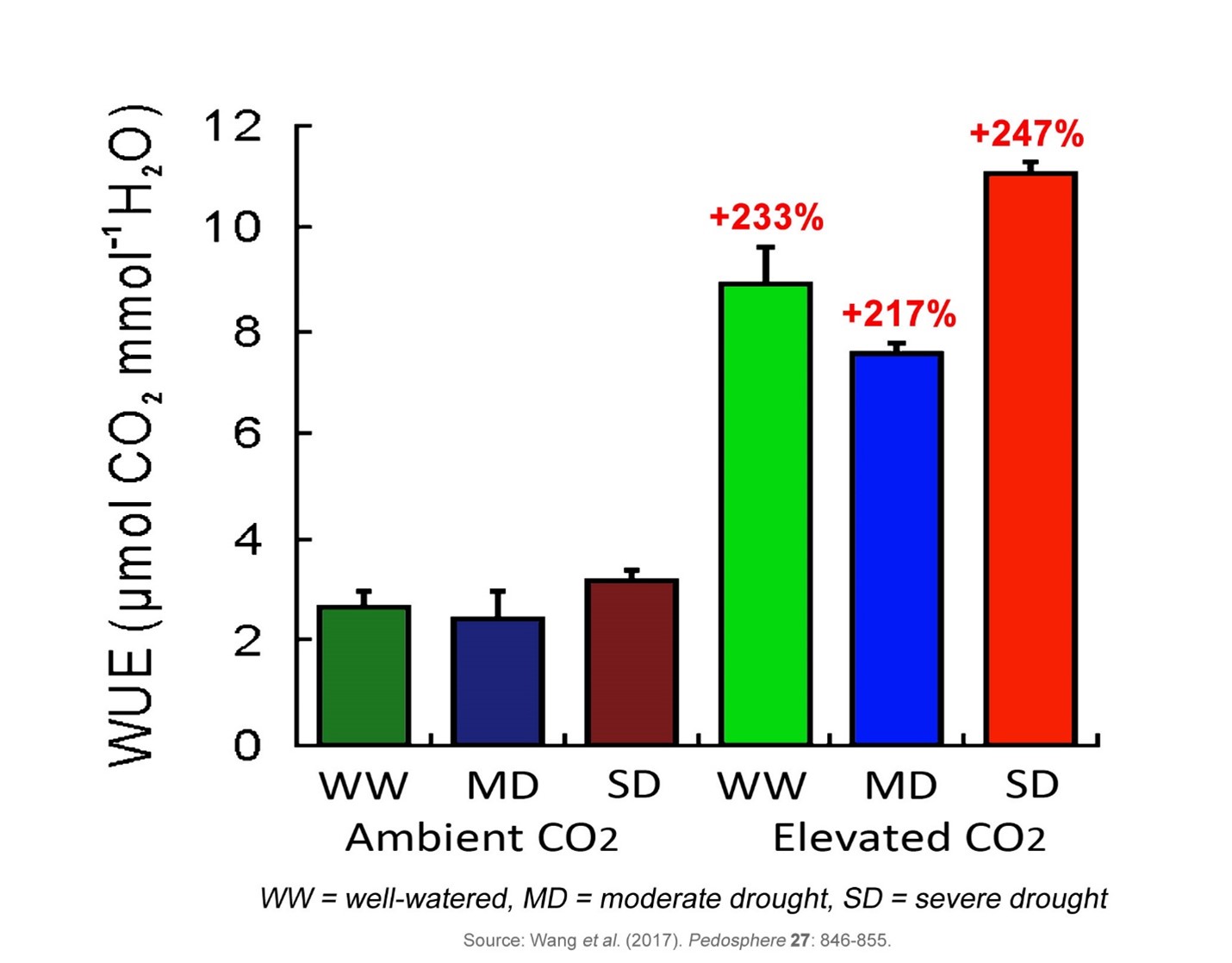
Figure 1. Water use efficiency (WUE) of soybean plants grown for 40 days under various water-supply treatments (WW = well-watered; MD = moderate drought; SD = severe drought) and atmospheric CO2 (ambient and elevated, elevated = twice ambient). The numbers in red text indicate the percent enhancement of plant WUE under elevated CO2 for a given water supply treatment. Source: Wang et al. (2017).
Gratefully, nature does not have to wait another century or so for the air’s CO2 concentration to double before reaping benefits from enhanced water use efficiency. It has already begun to profit in this regard from the approximate 50% increase in atmospheric CO2 that has occurred since the Industrial Revolution began.
Evidence of this fact is frequently noted in scientific studies utilizing dendrochronological methods and stable isotope analyses on long-lived tree species from all across the globe. Figure 2, for example, depicts the change in atmospheric CO2 and water use efficiency for an evergreen coniferous species in China. Since 1880, the rise in atmospheric CO2 has helped boost the water use efficiency of these trees by an incredible 60%.
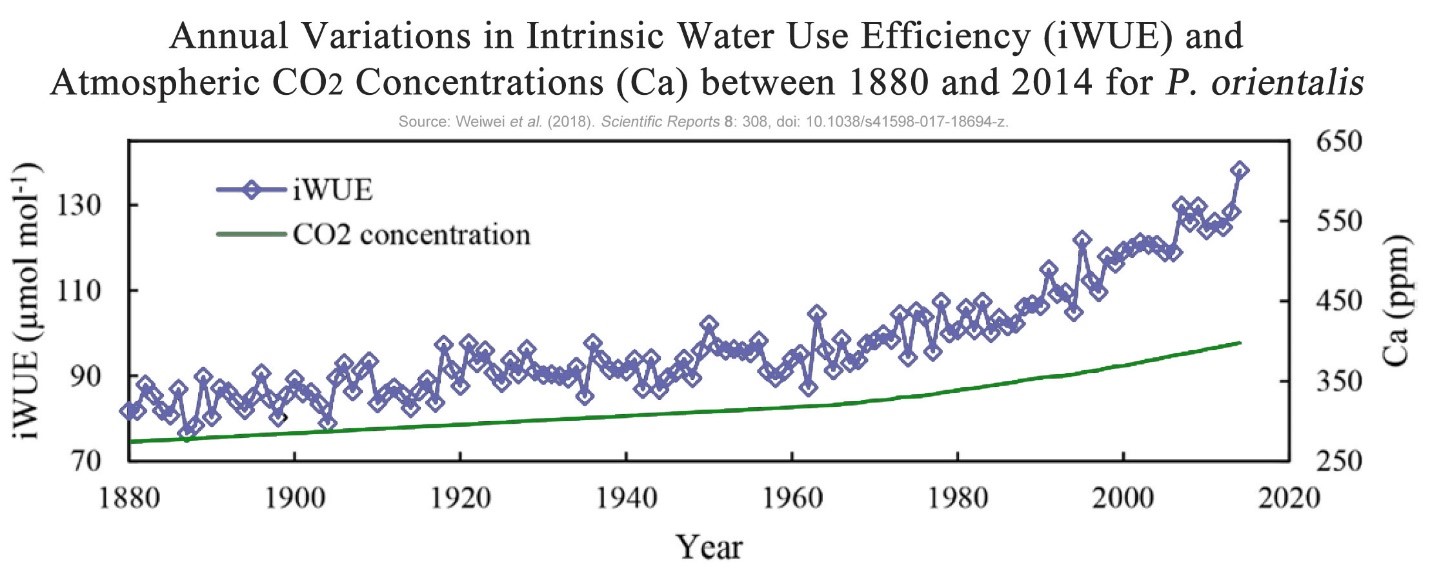
Figure 2. Annual variations in tree-ring averaged intrinsic water use efficiency (iWUE) and atmospheric CO2 concentrations (Ca) between 1880 and 2014 for P. orientalis. Source: Weiwei et al. (2018).
Global drought has NOT increased because of global warming.
Global COOLING is what increases drought the most.
Re: Re: Re: Re: Re: Death by GREENING!
By metmike - Feb. 2, 2025, 7:54 a.m.
Here's a perfect example of why they get it so wrong using the global drought graph from above. Please tell me where on this graph below, that the climate change droughts are and where the natural droughts are since the year 2000? Impossible because the pattern is THE EXACT SAME! The MSM, in 2025 tells us that EVERY drought is now caused by climate change to the point that they use the terms interchangeably.
https://www.climate.gov/news-features/featured-images/2017-state-climate-global-drought
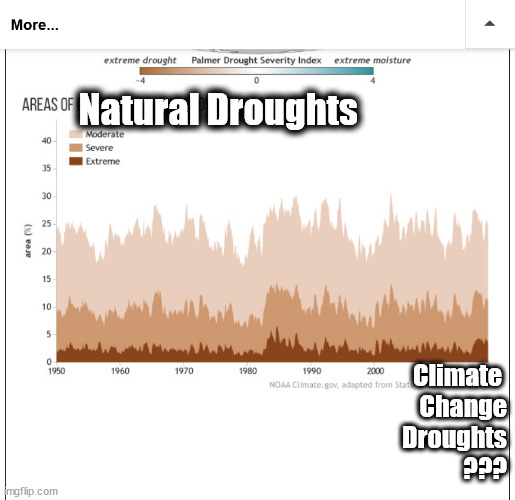
+++++++++++++++++++++++
Global cooling and LOW CO2 levels are what cause widespread, extremely long lasting droughts with catastrophic global and huge regional famines!
Here in 2025, we are living in a climate optimum with absolute, scientific certainty!!
Causes and consequences of nineteenth century droughts in North America
https://ocp.ldeo.columbia.edu/res/div/ocp/drought/nineteenth.shtml
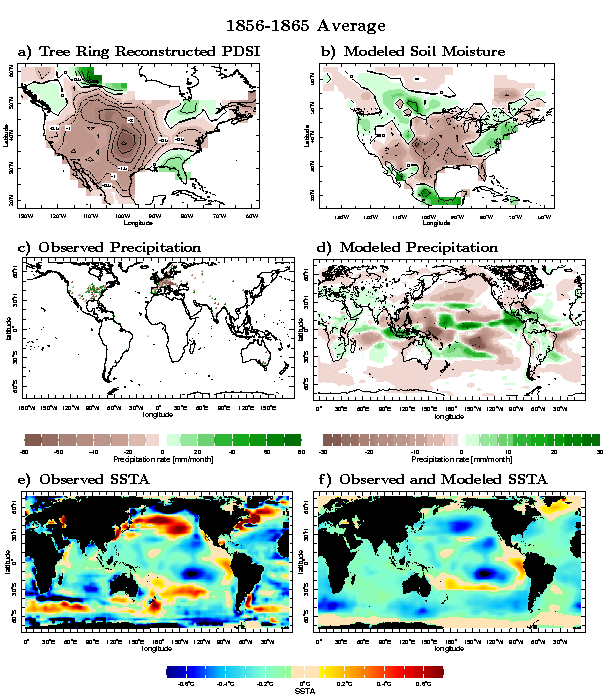
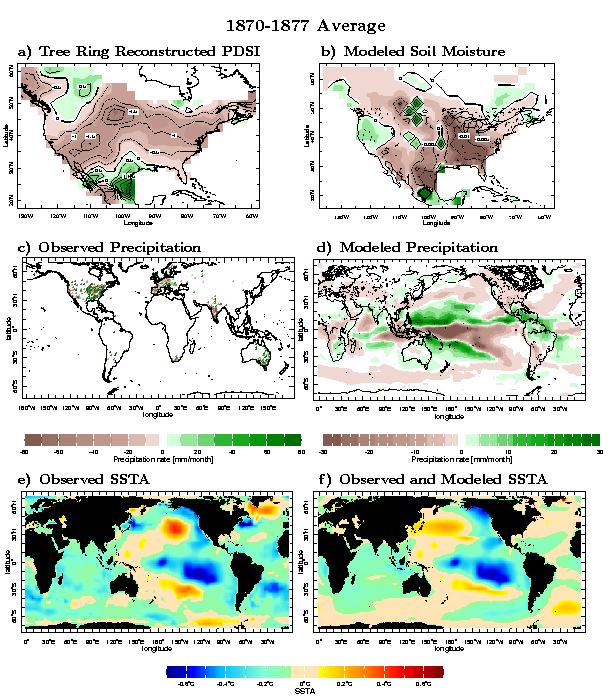
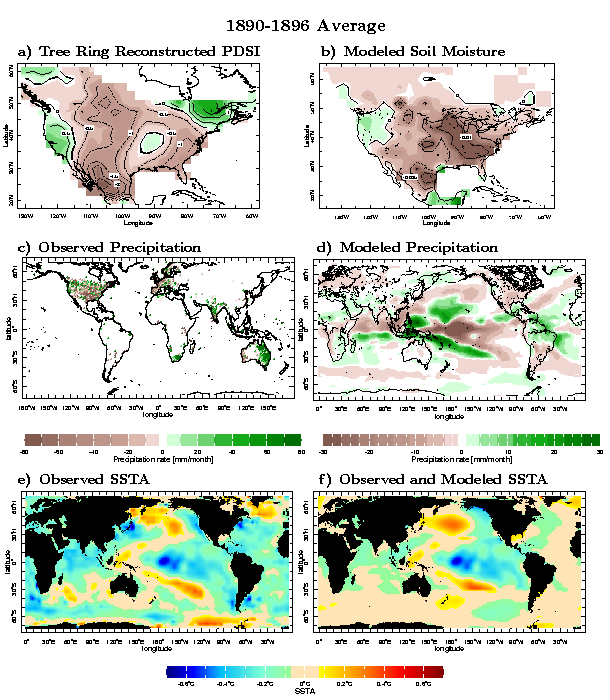
++++++++++++++++++++++++++++++++++++++++++++
You want a REAL climate CRISIS?
This is what it looks like:
Can you imagine if this below happened today? It's less likely because climate change and the current climate OPTIMUM is helping to PROTECT US!
The planet had a REAL climate crisis between 1876 and 1878.
50 million people died. 3% of the global population died from that real climate crisis!
https://news.climate.columbia.edu/2017/12/15/causes-great-famine-drought/

https://ui.adsabs.harvard.edu/abs/2017AGUFMGC51F..04S/abstract
The 1876-1878 Great Famine impacted multiple regions across the globe including parts of Asia, Nordeste Brazil, and northern and southern Africa, with total human fatalities exceeding 50 million people, arguably the worst environmental disaster to befall humanity.
NASA EXPLAINS THE DUST BOWL DROUGHT
https://www.nasa.gov/centers/goddard/news/topstory/2004/0319dustbowl.html
++++++++++++++++++
Climate change in the United States, with 100% certainty is helping to protect us from widespread severe droughts.
Summer Climate Change in the Midwest and Great Plains due to Agricultural Development during the Twentieth Century
https://journals.ametsoc.org/view/journals/clim/32/17/jcli-d-19-0096.1.xml

++++++++++++++++++++++++++++++++++++++++++++++++++++

We are indisputably living in a climate optimum for most life on this planet(that would still prefer a bit more warmth and a lot more CO2) and for growing crops in the United States!
+++++++++++++++
Cocoa is massively benefiting from all the factors PROVEN with authentic science above.
Larry,
I added to this post above just now for better understanding of the logarithmic (reduced) forcing of CO2 as it increases.
Larry,
I apologize because I read your post quickly and thought that cc meant the commodity/crop cocoa.
I just reread it and will need to make several more posts to address it properly.
For instance, you provided this graph below. This is completely wrong. Soybeans actually are the crop benefiting the most. I‘ll show you the impressive data from 290 studies on Sunday
Climate,l@change is ADDING to global crop production not reducing it.
More shortly.
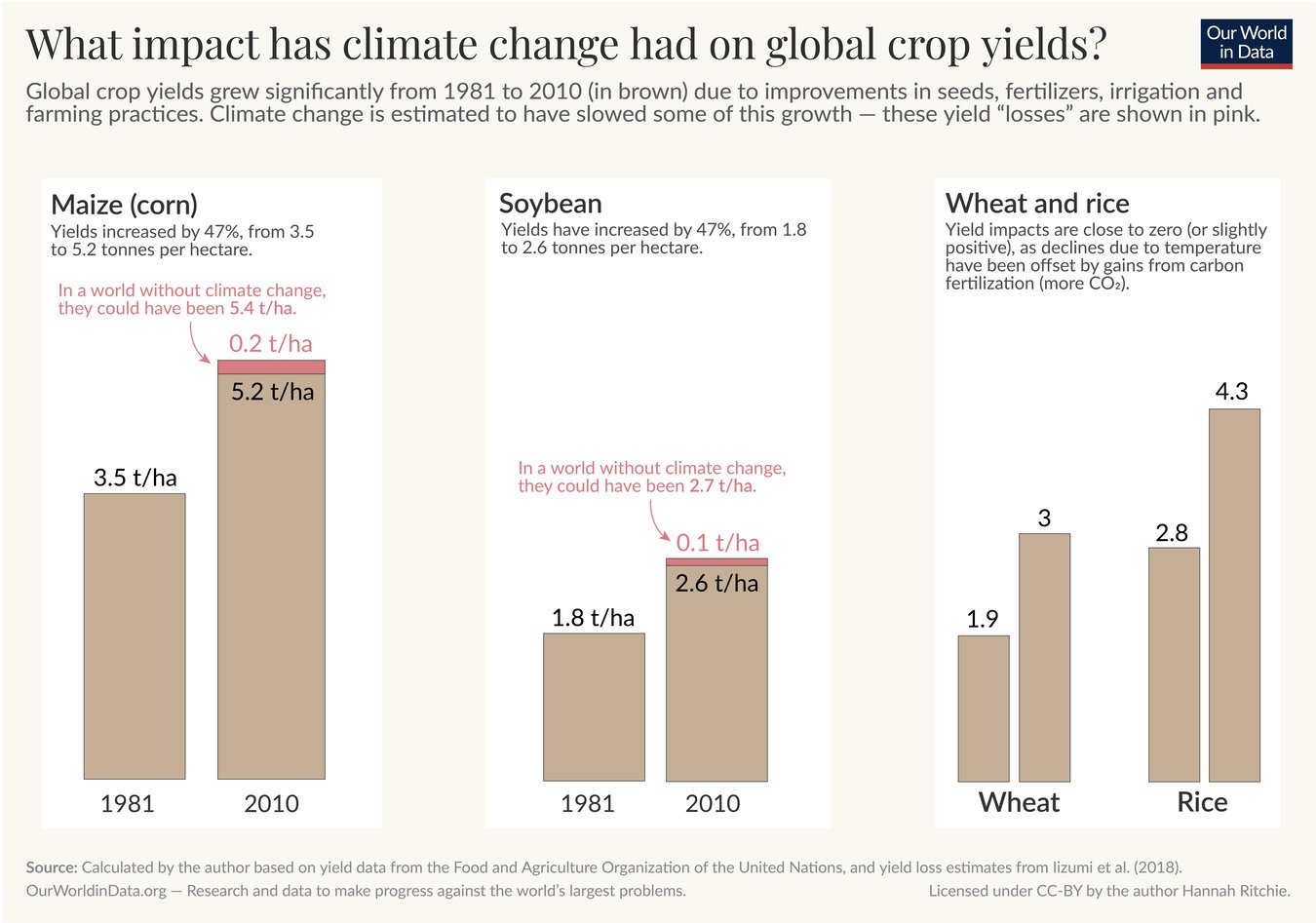
I'll go to Dr. Idso's site and retrieve the data to give you a detailed report on how just the CO2 impacted those crops.
In addition the increase in CO2 is making all those crops more drought tolerant/water efficient as I posted earlier with the science/agronomy.
In addition, global drought is not increasing but crops grown with higher CO2 need less rain/water. People that take away yield because of increasing drought are mistaken. They should be ADDING yield because ALL PLANTS do better in droughts because of more CO2.
Global warming is real but its impacting mainly night time/low temps with the coldest places warming the most.
More on Sunday.
There is a debate over how much technology has increased yields for crops and how much climate change has taken away or added. There is no way to take crops grown in 2025 and single out how much the contribution of each element is because all the impacting elements work together.
But we CAN single out climate change and CO2 in other ways.
1. Tree growth the past century is not impacted by changes in technology. Trees are responding to climate change/the amount of CO2 in the air. They may have different requirement than crops but they are a wonderful way to use as a way to assess the impact of just climate change by itself. Trees do not grow as fast in droughts or during extreme weather, although their resistance to adversity is greater than crops. However, this false narrative about climate change causing more extreme weather is not true. More high end, excessive rain events/flooding FOR SURE. More warm nights, FOR SURE. However, LESS cold and NOT more drought and all plants doing better in droughts because of elevated CO2.
Also, the measure of the planets greenness is INDEPENDENT of technology.
2. Crops/plants grown with enriched/elevated CO2 environments and studies that keep all other variables the same. Let's focus on these. We'll look at this on the next post.
+++++++++++++++++
As Carbon Dioxide Grows More Abundant, Trees Are Growing Bigger, Study Finds
https://e360.yale.edu/digest/carbon-dioxide-climate-change-bigger-trees
The profound difference below is only over a 20 year period, when CO2 increased by 42 parts per million. The increase over the last 100+ years is around 140 ppm(290 ppm to 430 ppm) or 3 times this. Based on studies and observations, this equates to +1% plant growth for every +5ppm of atmospheric CO2 depending on individual plants, this is around a boost of +28% in plant growth on the average from just the increase in CO2......which is THE main reason for climate change.
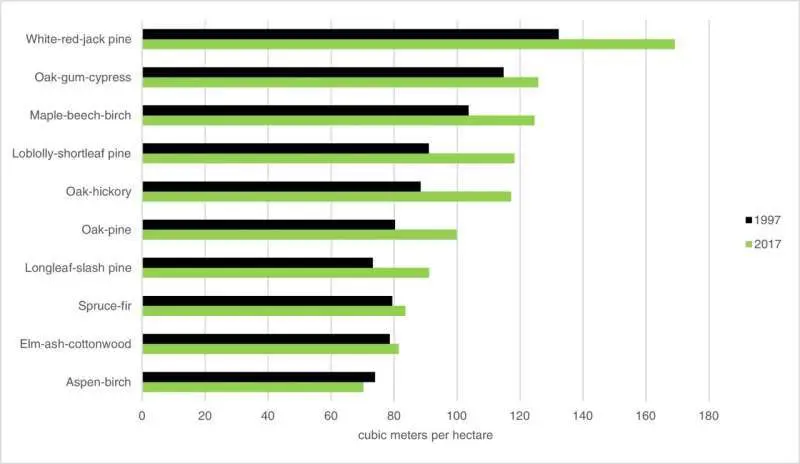
++++++++++++
Other studies looking at the entire planet, based only on greenness and climate change have found the same thing
Carbon Dioxide Fertilization Greening Earth, Study Finds
https://www.nasa.gov/technology/carbon-dioxide-fertilization-greening-earth-study-finds/
Global Green Up Slows Warming
https://earthobservatory.nasa.gov/images/146296/global-green-up-slows-warming
As mentioned previously, increasing CO2 causes plants to lose less water from transpiration and do much better in droughts. This is born out from observations that show the worlds driest areas, deserts are greening up from the increase in CO2. If climate change was causing MORE droughts, then deserts would be increasing and DE-greening would be taking place. The opposite is happening:
Deserts ‘greening’ from rising CO2
https://phys.org/news/2013-07-greening-co2.html
Let's look at the individual crops you mentioned.
Starting with soybeans that your source claims is negatively impacted by climate change.
All the data shows the complete opposite in most cases. In fact, I know from following this C3 crop closely that its massively robust response to climate change is at the top for crops.
Let's separate out other factors(technology for instance), so that we can look only at the photosynthetic benefits from increasing CO2 to soybeans.
Turns out that the impact of CO2 on soybeans has more studies than almost any other plant.
Here's how to access the empirical evidence/data from the site that has more of it than any other. Please go to this link:
http://www.co2science.org/data/data.php
Go to plant growth data base:
http://www.co2science.org/data/plant_growth/plantgrowth.php
Go to plant dry weight(biomass):
http://www.co2science.org/data/plant_growth/dry/dry_subject.php
Pick the name of a plant, any plant and go to it based on its starting letter. Let's pick soybeans. Go to the letter S,http://www.co2science.org/data/plant_growth/dry/dry_subject_s.php
Then scroll down and hit soybeans. This is what you get:
http://www.co2science.org/data/plant_growth/dry/g/glycinem.php
Glycine max (L.) Merr. [Soybean]
Statistics
| 300 ppm | 600 ppm | 900 ppm | |
| Number of Results | 290 | 29 | 7 |
| Arithmetic Mean | 47.9% | 70.7% | 80.9% |
| Standard Error | 2.2% | 7.1 | 8.9% |
This tells us that there were 290 studies with the CO2 elevated by 300 ppm. The mean increase in plant biomass was 47.9% from all those studies.
The individual studies are listed below that.
USA Soybean yields in the real world since 1988 have doubled while CO2 increased by 65 ppm, so we have strong corroborating evidence. Alot of that was from technology but a lot was from climate change.
We should keep in mind that the benefits from the last +140 ppm increase WERE MUCH GREATER than the benefits from the next +140 ppm, so that rate was HIGHER than the rate from these studies of ELEVATED CO2 levels.
++++++++++++++
Of the crops mentioned, we can see that soybean yields are being boosted the most. Now lets look at the other crops.
Corn/Maize. Using the same searches with links below for you to follow. Not quite as robust as soybeans.
I will add this point to corn yields.
Climate change causes slightly warmer and more humid nights. Corn matures based on growing degree days. Warmer nights increase growing degree days and cause corn plants to mature faster.
This is a NEGATIVE for yields because after pollination, the longer the plant has to fill kernels the more plump the kernels get. Warmer nights SHORTEN the filling time and extremely warm nights over long periods cause "heat fill" which can significantly reduce yields from small kernels.
https://www.co2science.org/data/data.php
https://www.co2science.org/data/plant_growth/plantgrowth.php
https://www.co2science.org/data/plant_growth/dry/dry_subject.php
https://www.co2science.org/data/plant_growth/dry/dry_subject_c.php
https://www.co2science.org/data/plant_growth/dry/z/zeam.php
Percent Dry Weight (Biomass) Increases for
300, 600 and 900 ppm Increases in the Air's CO2 Concentration:
For a more detailed description of this table, click here.
Zea mays L. [Corn]
Statistics
| 300 ppm | 600 ppm | 900 ppm | |
| Number of Results | 60 | 16 | |
| Arithmetic Mean | 32.1% | 27.6% | |
| Standard Error | 5.4% | 3.7 | |
Now let's do wheat:
https://www.co2science.org/data/plant_growth/dry/t/triticuma.php

Percent Dry Weight (Biomass) Increases for
300, 600 and 900 ppm Increases in the Air's CO2 Concentration:
For a more detailed description of this table, click here.
Triticum aestivum L. [Common Wheat]
Statistics
| 300 ppm | 600 ppm | 900 ppm | |
| Number of Results | 490 | 17 | 12 |
| Arithmetic Mean | 38.5% | 63.3% | 33.8% |
| Standard Error | 1.5% | 12.8 | 7.2% |
And for rice:
https://www.co2science.org/data/plant_growth/dry/o/oryzas.php

Percent Dry Weight (Biomass) Increases for
300, 600 and 900 ppm Increases in the Air's CO2 Concentration:
For a more detailed description of this table, click here.
Oryza sativa L. [Rice]
Statistics
| 300 ppm | 600 ppm | 900 ppm | |
| Number of Results | 428 | 22 | 3 |
| Arithmetic Mean | 33.3% | 141% | 34.3% |
| Standard Error | 1.5% | 37.5 | 3% |
Like the other 3, the number of studies at 428 are enormous. A huge increase in plant growth. Not yields but plant growth, which is the best data we have and outstanding but not the PERFECT data of actual yields. Plant growth and yields strongly correlate.
If we were to rank those 4 crops based on the many studies done based on benefits from increasing CO2:
1. Soybeans, easily at the top +47.9% from 290 studies
2. Wheat had 490 studies and +38.5%
3. Rice had 428 studies and +33.3%
4. Corn was just behind that with 60 and 32.1%
This studies were done independent of technology and keeping all other variables the same.......while elevating CO2.
The optimal level of CO2 for plants is 900+ ppm so it's a no brainer that boosting the level above the current ambient level of 430 ppm will cause plants to grow faster, bigger and with higher yield potential.
But there's more to it than this, some of which I pointed out previously:
https://extension.okstate.edu/fact-sheets/greenhouse-carbon-dioxide-supplementation.html
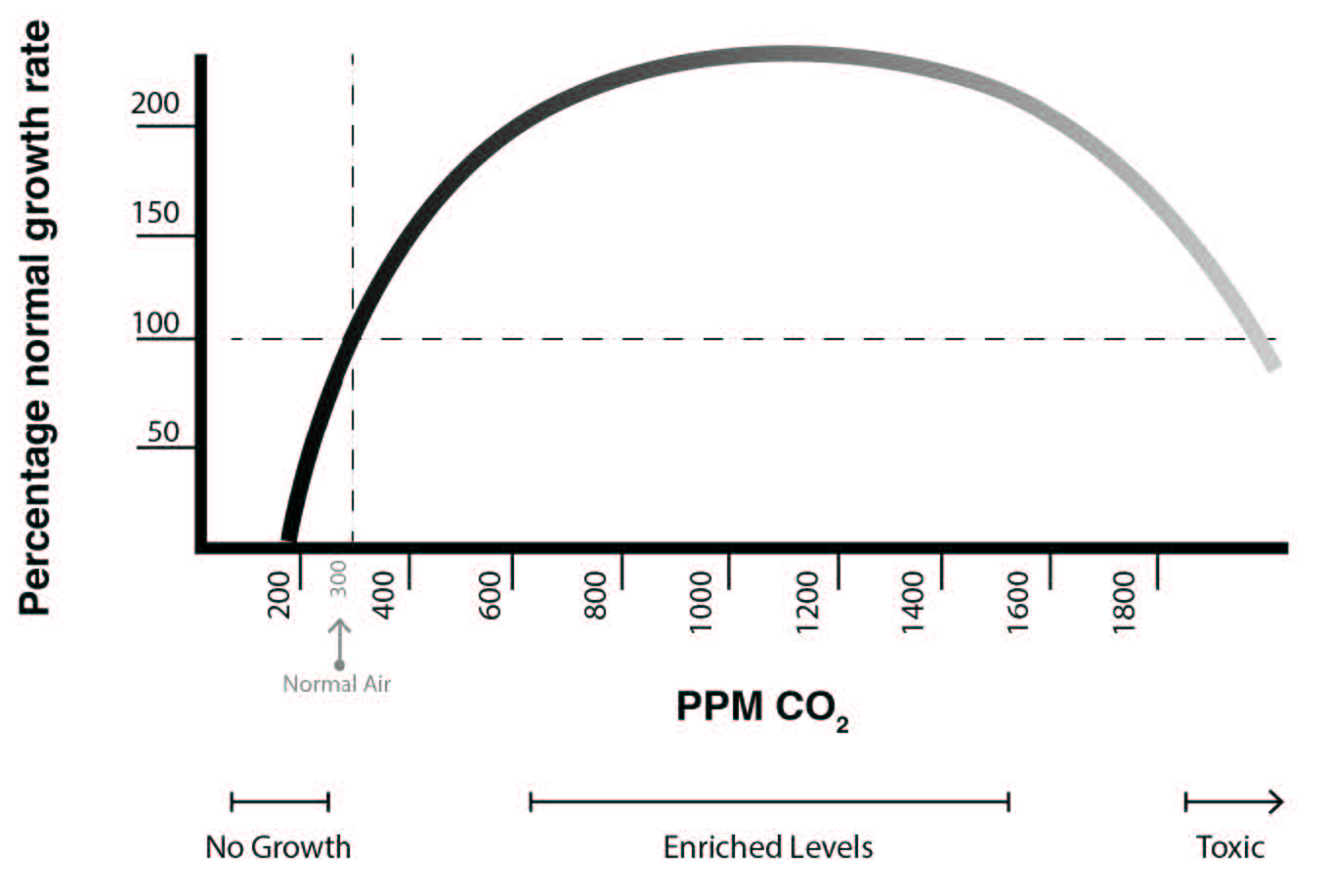
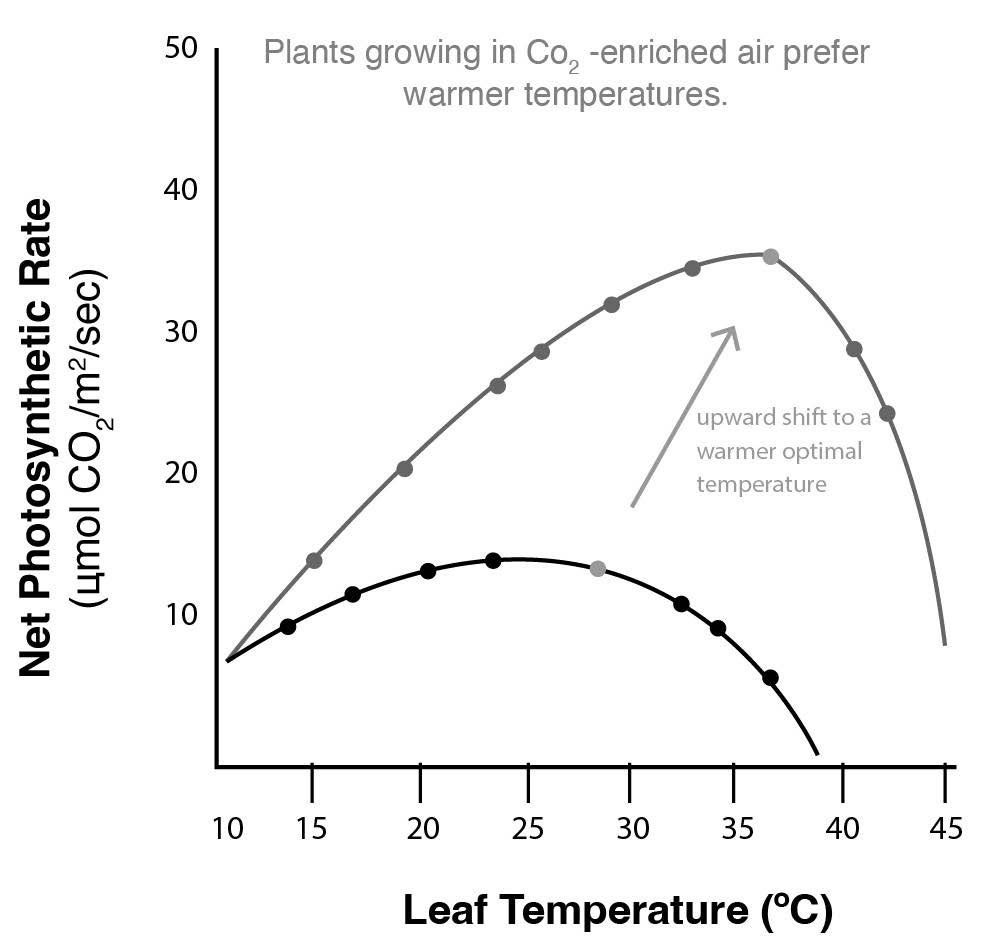
The last chart above is misleading.
Slightly warmer temperatures in the real world do increase water needs of plants slightly(though more CO2 causes them to adapt to warmer temperatures) and as I mentioned, in the case of corn, excessive warmth after pollination, during filling will reduce kernel filling time.
Larry,
You also mentioned longer growing seasons which I agree with. The risk of early freeze damage to crops in the Midwest, for instance the past 3 decades has been greatly reduced.
Also it allows for a slight expansion northward to agriculture.
To claim that it's "too hot" for growing soybeans(and other crops), for instance is to completely ignore agronomy and the real world.
Corn on the other hand can suffer from heat fill from excessively warm nights over an extended period(causing the plants to mature too fast-reducing kernel filling time). No matter how much the benefits from higher CO2 are, there will still be some additional heat fill to corn from global warming which reduces yields. Not enough to offset the much greater benefits but it is still a significant negative.
Wheat is often called a "weed" because it can withstand adversity and higher CO2 makes it even better at that.
I've followed and studied those 3 crops closely for 37 years but don't know enough about rice to comment.
Larry,
You already know this but unlike most people on topics like this, I don't search around to find the studies that line up with what I want to believe or what I need to support a position.
I don't use other people's opinion or biased science.
I AM a scientist.
I use the BEST, reliable EMPIRICAL DATA sources and the principles/laws of agronomy, physics, meteorology, science and my own analysis to gain objective discernment based on authenticity.
I don't get paid grant money to do biased studies which, sadly defines much of science today.
I don't belong to a political party(am independent). I use the scientific method which first looks for reasons for why I might be wrong (to learn and fact check myself) and not just cherry pick stuff that lines up with what I think I already know.
If somebody finds real flaws in my work, I celebrate it and thank them for helping me to get it right.
Every good meteorologist knows that our last forecast is the only one that counts and the best forecasters are great at being THE FIRST TO CHANGE THEIR FORECAST, which means admitting they/we were wrong initially.
Being wrong and realizing it in timely fashion is part of getting it right.
Successful commodity speculators embrace that or they perish.
In the 1990s and early 2000s, I believed that we were having a climate crisis for warm blooded creatures(not plants) because I didn't have access to the data or the understanding.
Thanks to the internet, we all have almost unlimited access to use it for AUTHENTIC enlightenment............if we want that.
Hey MM,
Thanks a bunch for these last well explained and sourced posts!
There’s a lot there. So, I decided that my best choice is to post a portion at a time. I posted about soybeans by quoting you word for word. I said it is from a “Midwest pro met”.
I prefaced with this:
“As promised with the help of a Midwest pro met., here is the first response supporting the net benefit of CC to crops. This one covers soybeans (posts to cover other crops to come later):”
I’m waiting for a reply as it hasn’t been read yet. We’ll probably go back and forth. It may take a few days. Only after our soybean discussion is done and if I feel satisfied that I got our point across (they’re very tough debaters there), I’d then post about the next crop (probably corn). And so on.
YW, Larry!
You can pick whatever is useful from,it.
I always enjoy it and I have a TV interview on climate change coming up in 2 weeks and I was thinking of it as a review of some good facts that nobody ever reads or hears about.
I‘ll post the link afterwards. Not sure if it’s 30 minutes or an hour.
Craig Rucker from CFACT is supposed to be on with me
Hey Mike,
Unfortunately, the source I got from you that I then cited in my reply to Charlie at AmericanWx on soybeans, CO2Science, has been rejected as not being balanced:
A quick check indicates that CO2science is not a balanced website. Its advocating against US regulation of CO2 emissions and focusing on the benefits of CO2 on plant growth without acknowledging offsetting adverse impacts. I'd put it in the climate denial camp. I ourworldindata piece I linked above is more trustworthy. Recent gains in yields are mainly from improved seed genetics and increased fertilizer and other inputs. You have to strip that out to get climate change impacts.
I googled up this recent Nature paper which finds significant future negative impacts on agriculture, even after farmer adaptation, albeit from a high emissions scenario. I haven't gone through the literature review section but that would be a good place to start on recent scientific work in this area.
https://www.nature.com/articles/s41586-025-09085-w.pdf
————————
I then googled CO2Science, myself, and saw at the reputable “mediabiasfactcheck” that it’s rated as “low” on factual reporting and “pseudoscience”. It says that it “promotes climate change denial and misinformation”.
https://mediabiasfactcheck.com/co2-science-bias-and-credibility/
Sorry, but unfortunately this source, just like “Watts Up with That?”, isn’t going to cut it for my use due to bias as mediabiasfactcheck rates it with the same “pseudoscience” rating that it rated Watts with. I appreciate your help though.
Thanks much, Larry!
Yes, I figured that would be the response and it's because Dr. Idso provides AUTHENTIC data that contradicts the false climate crisis narratives.
Anybody that does that, including me, automatically is considered a "denier" or "low credibility".
What's sort of comical about that is that this site is mainly passing on the authentic, empirical data. Not words or interpretation. DATA.
Here is a list of the actual 290 studies that were done on soybeans. None of these were just made up based on bias. It defines the most powerful source to use for interpretation in understanding this science.
https://www.co2science.org/data/plant_growth/dry/g/glycinem.php
People that reject sources that show the data on 290 soybean studies because they claim the source passing it on is low credibility..... JUST DON'T WANT TO BELIEVE THE DATA.
When I look at sources, IF I CAN'T VERIFY their words, I will judge them based on credibility. However, if the source has indisputable, detailed EMPIRICAL DATA, I use them no matter what. in some cases, I'm not using them, I'M USING THE DATA they are passing on!
I showed you plenty of other studies from sources that they should accept which show the planet is greening up. Even deserts are greening up. That's not happening from technology. It's from the increase in CO2.
This is indisputable, additional evidence that shows the same thing as CO2's Science's authentic data.
Empirical data doesn't have an opinion. In this case CO2 Science didn't take only data from studies that they wanted to include. It's all there in it's beautiful, comprehensively listed detail.
This is why, years ago I stopped going to places to demonstrate what I just explained to you, Larry.
When people are TAUGHT to believe in something, they interpret all new information to line up with what they think they know. Their cognitive/confirmation bias controls how they interpret, even indisputable comprehensive data. In this case, they use the source to reject it.
Well guess what?
Only sources like this, including me will present the data that contradicts the false climate crisis narrative which means THEY WILL NEVER BELIEVE IT!
On WUWT. I like a lot of their stuff but they have turned into a REAL denier source and I rarely post their anymore, even though they also present good authentic, empirical data at times...........that I will use because ITS THE DATA!
WUWT is loaded with posters that don't believe in the indisputable physics of greenhouse gas warming. If you disagree with one of their anti physics, lack of understanding of the atmosphere posts, you will get trashed.
That's not happened to me because I won't waste my time correcting an anti physics post there since these REAL deniers will NEVER believe CO2 is warming the planet. NEVER!
It sure as heck is based on 100% provable physics and I mentioned the bad things already.
However for plants and crops this is the best thing that could have ever happened by an extraordinarily wide margin. If we cooled the planet back down and reduced the CO2 below 300 ppm again, 1 billion people would starve to death within a few years.........technology or not. This is based on the empirical data from thousands of studies from different plants and crops. Dr. Craig Idso is just the best source for passing that along about authentic INDIVIDUAL crops/studies.
I know because I've spent 2 decades searching for and accessing all of them.
https://en.wikipedia.org/wiki/Craig_D._Idso
Craig D. Idso is the founder, president and current chairman of the board of the Center for the Study of Carbon Dioxide and Global Change,[2][3] a group which receives funding from ExxonMobil and Peabody Energy and which promotes climate change denial. He is the brother of Keith E. Idso and son of Sherwood B. Idso.
++++++++++++++++
This opening paragraph is farcical to anybody that uses authentic science based on empirical data and IS OBJECTIVE.
By their definition of climate change denial, anybody that contradicts false narratives based on junk science, using indisputable, comprehensive authentic empirical data is a denier and must not be believed.
That, actually was why they concocted that term to describe us deniers.
Label us as deniers so that people will completely REJECT our empirical data, authentic science and use of indisputable proof of physical laws in the atmosphere and biosphere.
Ironically, the people that refer to people like me as a denier............are the real deniers.
I am extremely happy to provide you with whatever you need, which this thread is about and more if you want if you care to waste your time arguing with the real deniers with closed minds because they are indoctrinated into climate religion.
Alex, our wonderful moderator that started this site was one of the few people that completely changed his mind on climate change because of my posts here but he was extraordinarily rare and open minded.
Think of trying to get mcfarm to change his view on Donald Trump for an extreme analogy.
You know this group of people better than me and maybe you think they will listen to you on this topic. However, if they just rejected the objective, authentic, indisputable empirical data that defines the topic. .............what will they accept?
Here's another post today that I connected with the idea's at this thread.
September 2025 global temps up a tad from August
Started by metmike - Oct. 6, 2025, 3:35 p.m.
One huge problem is people and scientists using speculative global climate models like they are more than speculative in nature is that the models are not able to capture/represent several elements accurately.
A big one thats often discussed is clouds but the one we are currently discussing is PHOTOSYNTHESIS.
5 Conclusion
Our work suggests that ESMs may significantly underestimate global photosynthesis, especially in tropical forests, because they do not take vegetation structure into account. The dominant effect that introducing clumping has in our study is to alleviate light limitation at lower canopy levels. This tends to have the greatest impact where leaf area index is high and where photosynthesis is not limited by light in higher canopy layers. In our study this effect accounted for an additional uptake of carbon by photosynthesis globally of 5.53 and 4.18 PgC/year between 20°S and 20°N latitude.
+++++++++++++++++
Looky here at this study using photosynthesis.
https://earthobservatory.nasa.gov/images/146296/global-green-up-slows-warming
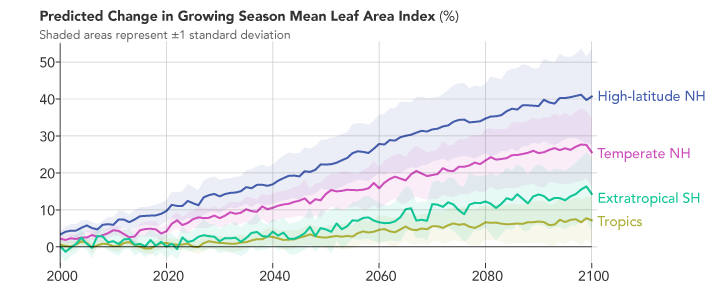
2000 - 2100
The paper’s authors reviewed more than 250 published articles that have used satellite data, modeling, and field observations, to understand the causes and consequences of global greening. Among the key results, the authors noted that on a global scale greening can be attributed to the increase of carbon dioxide in the atmosphere. Rising levels of carbon dioxide increase the rate of photosynthesis and growth in plants.
There is an interesting consequence of this global green up: as vegetation consumes some of the heat-trapping carbon dioxide it also performs evapotranspiration—a function similar to human sweating—which can have a cooling effect on the air. Scientists say that global greening since the early 1980s may have reduced global warming by as much as 0.2° to 0.25° Celsius (0.36° to 0.45° Fahrenheit). In other words, the world would be even warmer than it is if not for the surge in plant growth.
“It is ironic that the very same carbon emissions responsible for harmful changes to climate are also fertilizing plant growth,” said co-author Jarle Bjerke of the Norwegian Institute for Nature Research, “which in turn is somewhat moderating global warming.”
According to climate models, the future looks even greener. The second map shows what the green-up might look like in the future based on the Coupled Model Intercomparison Project (CMIP5) climate model, under a scenario in which increases in greenhouse gases lead to almost 5° Celsius (9° Fahrenheit) of warming by the end of the 21st century. Specifically, it shows the predicted change in the growing season’s “leaf area index” from 2081-2100 relative to 1981-2000. The chart below the map shows the predicted changes by latitude. Notice that high latitudes in the Northern Hemisphere are still expected to change the most.
“This greening and associated cooling is beneficial,” said Shilong Piao of Peking University, and lead author of the paper. “But reducing carbon emissions is still needed in order to sustain the habitability of our planet.”
+++++++++++++++
Let me repeat the lines above: The paper’s authors reviewed more than 250 published articles that have used satellite data, modeling, and field observations, to understand the causes and consequences of global greening.
According to climate models, the future looks even greener. The second map shows what the green-up might look like in the future based on the Coupled Model Intercomparison Project (CMIP5) climate model, under a scenario in which increases in greenhouse gases lead to almost 5° Celsius (9° Fahrenheit) of warming by the end of the 21st century.
++++++++++++++++++++++++
metmike: This huge green up is after the warming. In fact, they site the most extreme, unlikely case for warming of +5 deg. C (9 deg. F)!!!
U.N. report authors say researchers should avoid suspect models
+++++++++++++++++++++++++++++++====
https://acc.climateneutralgroup.com/en/news/five-future-scenarios-ar6-ipcc/
SSP5-8.5:
This is a future to avoid at all costs. Current CO2 emissions levels roughly double by 2050.
+++++++++==
CO2 has increased around 140 ppm the past 100 years. This impossible scenario, would feature CO2 levels increasing by 430 ppm(3 times that in just the next 75 years).
Not only could that never happen with unlimited fossil fuels, most fossil fuels will RUN OUT before that!!!!!
Yet MANY sources use this fairy tale, flawed speculative climate model stuff like its an assumed business as usual scenario if we don't make drastic cuts. But those same sources reject CO2 Science and Dr. Idso's authentic empirical data. Go figure! And you can't change their minds once they've decided they already know enough to understand it.
++++++++++++++++
The biggest risk, by far would be if we cut CO2 emissions too much. The entire GREENED UP planet now has a greatly elevated demand for CO2 just to sustain photosynthesis for all plants, including crops. This is needed to feed 8 billion people. If CO2 emissions dropped too fast, the greener planet, gobbling it up at a much greater rate would take out more than we put in. THIS would be the disaster.
Crop yields and food production, after decades of big increases would fall at a time when the world population was still going up.
The result?
This would lead to a reduction in the world's population because of the shortfall in food.
Climate change has been the best thing to happen to this planet during the current climate optimum for most life. Without it, there would not be enough food for 8 billion people. Increasing CO2, with technology can feed more people.
"Denier" Dr. Craig Idso is in some great company!
Here's a few of the most outspoken of many dozens:
https://en.wikipedia.org/wiki/Richard_Lindzen
++++++++++++
Judith Curry
https://en.wikipedia.org/wiki/Judith_Curry
Roy Spencer
https://www.sourcewatch.org/index.php/Roy_Spencer
https://en.wikipedia.org/wiki/Roy_Spencer_(meteorologist)
+++++++++++++++++++++
These elite scientists could claim that 2+2 =4, when climate crisis scientist Michael Mann insisted it was 5 and people in the climate crisis religion would believe Mann!
That was a joke
Personally, I don't follow THE PERSON or what they believe in. I follow their empirical data and their presentation of how the physical laws of the atmosphere work.
I get that 99.9% of the public are not scientists or atmospheric scientists and can't do that.............very unfortunately. However, most people have the basic intelligence, if they want to apply it objectively to see and understand basic empirical data and observations of the atmosphere and biosphere (like what Idso provides at CO2 Science) and use that to obtain authentic discernment of the realms that the empirical data was gathered in.
That's what people should be doing with the empirical data at CO2 Science.
My objective here at MarketForum and elsewhere is to provide people with this empirical data and sources on science, trading, weather, agronomy positive quotes, philosophies about love, politics(that includes personal opinions-politics) and let them use that......apply that themselves using their own brains.
One of the best parts for me personally, is that in sharing information, I constantly learn a ton and posters like WxFollower, joj, cutworm and mcfarm teach me a few things along the way.

The descriptions about the views of these so called "deniers" on the previous page are mostly lies. For instance, they claim this about Dr. Spencer:
https://www.sourcewatch.org/index.php/Roy_Spencer
Spencer is an anthropogenic global warming denier who believes that climate change is not human caused and will have minimal impact.
This is the truth:
December 19th, 2022 by Roy W. Spencer, Ph. D.
https://www.drroyspencer.com/2022/12/climate-sensitivity-from-1970-2021-warming-estimates/